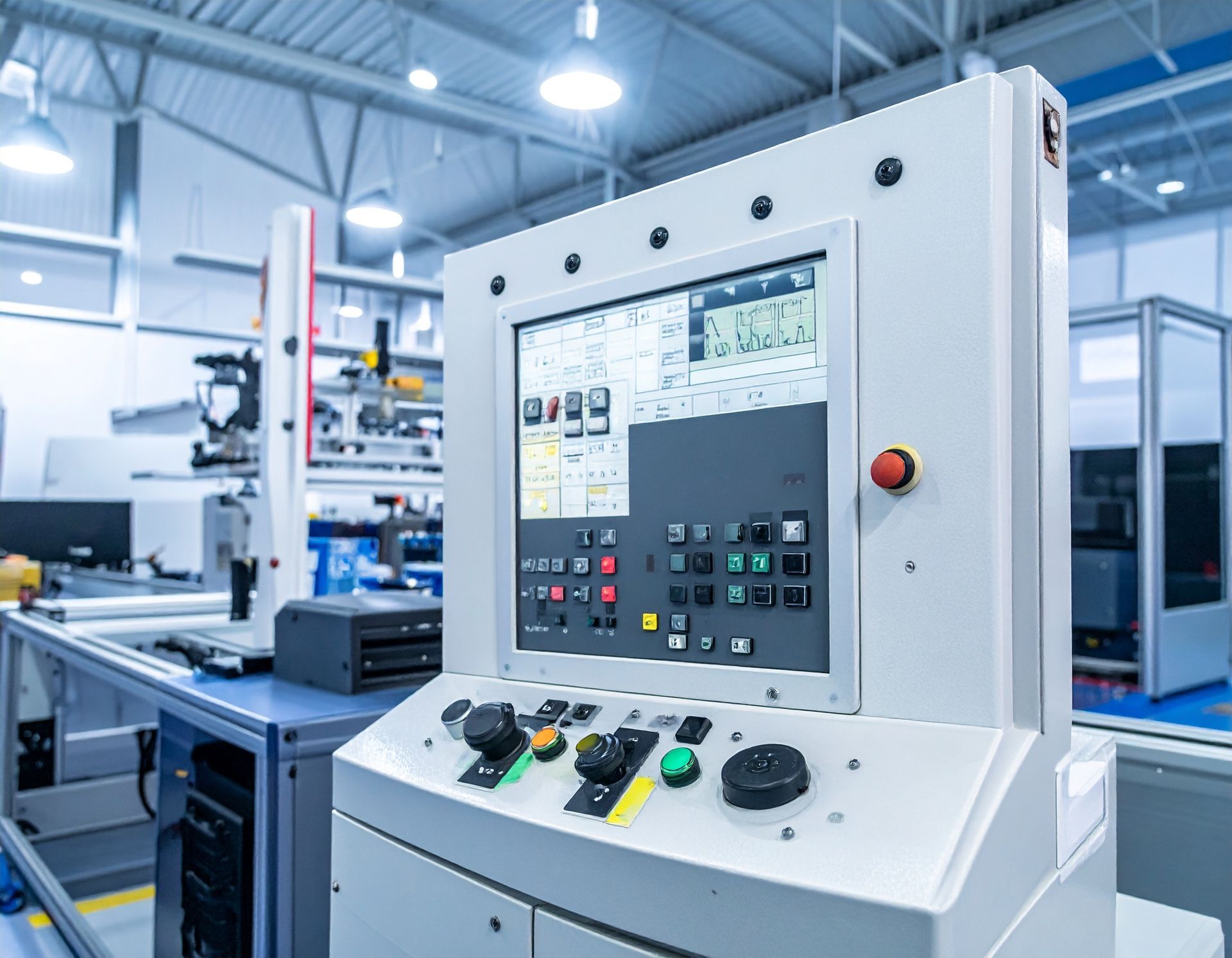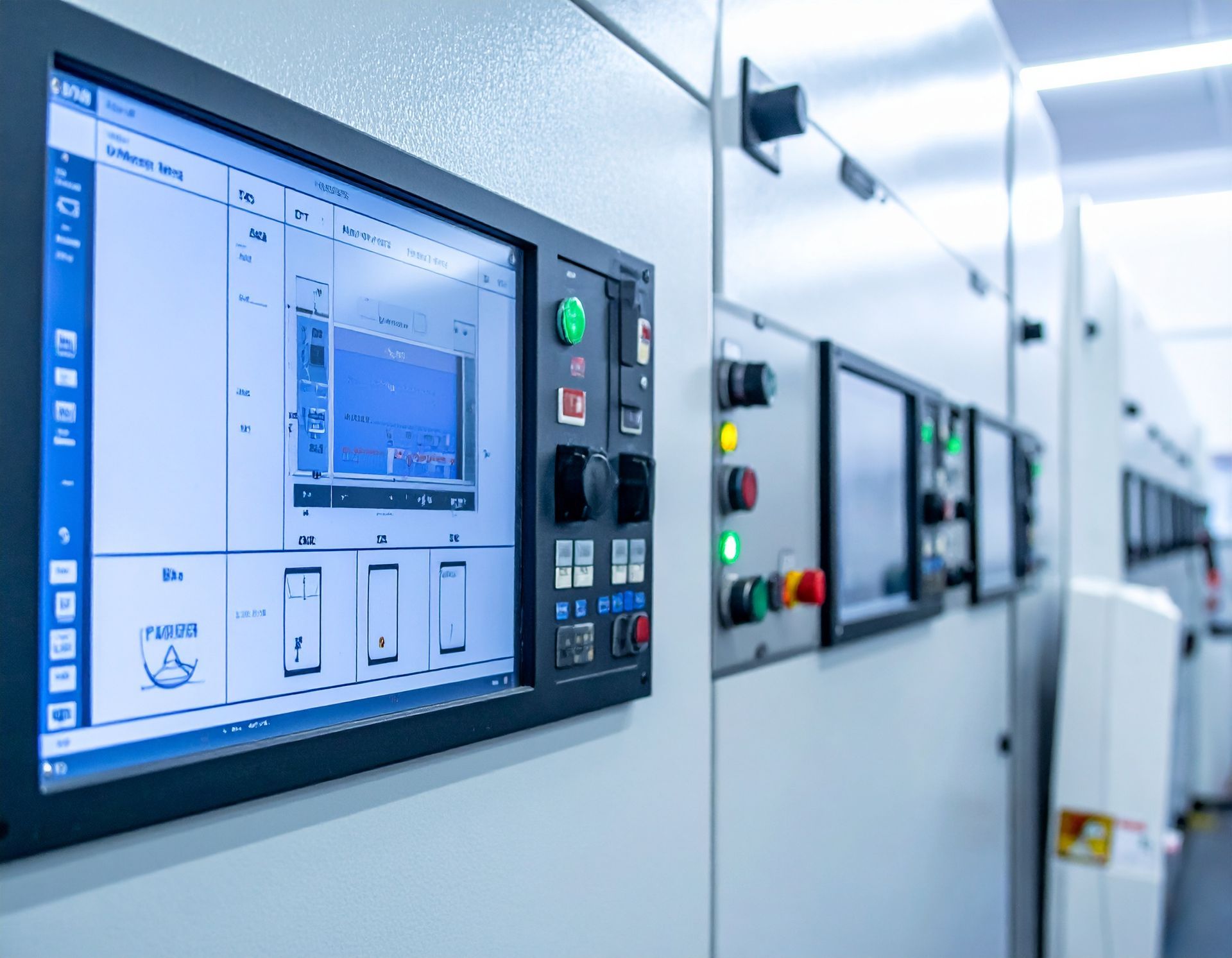Understanding Automation PLC: A Beginner's Guide
Key Highlights
- A programmable logic controller (PLC) is a rugged industrial computer that automates and controls machinery.
- PLCs operate by scanning inputs from sensors, executing a user-defined program, and updating outputs to control devices.
- The core components of a PLC system include a central processing unit (CPU), input/output modules, and a power supply.
- PLC programming languages like Ladder Logic allow for flexible and precise process control in the manufacturing industry.
- These devices are essential for industrial automation, enhancing efficiency, reliability, and scalability in various applications..
Introduction
Welcome to the world of industrial automation! If you’ve ever wondered what makes modern factories so efficient, the answer often involves a Programmable Logic Controller, or PLC. These powerful devices are the brains behind countless automated processes, from assembly lines to complex machinery. By using programmable logic, PLCs have revolutionized industries by improving process efficiency and reliability. This guide will walk you through what a PLC is, how it works, and why it's a cornerstone of modern manufacturing.
What Is a PLC in Automation?

A programmable logic controller is essentially a specialized industrial computer built to withstand harsh factory environments. Unlike a regular PC, a PLC is designed for one primary purpose: managing and automating electromechanical processes. These robust control systems are the workhorses of the factory floor.
You can find PLCs in various sizes, from pocket-sized units to large, rack-mounted systems. Their main job is to provide reliable process control for machinery, making them indispensable in today's automated world.
Definition and Historical Background of PLCs
Programmable Logic Controllers (PLCs) are industrial computers that monitor inputs and control outputs based on custom programming. Before their invention, industrial control depended on hard-wired relay systems. These systems used numerous relays, timers, and switches that were complex to wire, troubleshoot, and modify.
The turning point came in the late 1960s when the automotive industry sought a more flexible alternative. The first programmable controllers were developed to replace these cumbersome relay systems. This innovation made it possible to change control logic through software instead of manually rewiring entire panels.
This shift marked a significant evolution from mechanical relays to digital control. PLCs offered a more reliable, durable, and easily programmable solution, setting the stage for the sophisticated automation we see today. They are truly specialized industrial computers built for the demands of the factory floor.
The Role of PLCs in Modern Automation Systems
In modern automation systems, the programmable logic controller acts as the central hub for controlling industrial machines. It serves as the physical interface between devices on the factory floor and higher-level monitoring systems like SCADA. Have you ever wondered how a robotic arm knows exactly when to move? A PLC is likely giving the commands.
From managing conveyor belts to controlling robotic cells and regulating temperature, PLCs handle a wide range of industrial applications. The central processing unit within the PLC executes program logic to interpret sensor data and send commands to motors, valves, and other equipment.
This capability allows for precise, real-time control over complex processes. By managing multiple inputs and outputs simultaneously, PLCs ensure that automation systems run efficiently, safely, and with high productivity, making them a fundamental component of industrial technology.
Key Components of a PLC System

To understand how a PLC works, it helps to know its basic parts. Every PLC system is built around a few core components that work together to execute control tasks. These include the processing unit (CPU), the input/output (I/O) modules, and a power supply, all typically housed on a mounting rack.
Depending on the complexity of the task, you might also find expansion modules and components for various communication protocols. Let's break down these essential parts to see what role each one plays in the system.
Central Processing Unit (CPU)
The Central Processing Unit, or CPU, is the brain of the entire PLC system. This powerful processing unit is responsible for executing the user-created program, making calculations, and controlling all other components. It operates in real time to ensure that decisions are made instantly.
The CPU has two main operational modes: programming mode and run mode. In programming mode, it accepts the logic downloaded from a PC. When switched to run mode, it continuously executes that logic to manage the industrial process. This involves reading inputs, processing the program, and updating the outputs.
Furthermore, the CPU performs internal diagnostics and housekeeping tasks to ensure everything is running smoothly. This constant self-checking is crucial for maintaining system reliability and safety during data acquisition and control operations.
Input and Output (I/O) Modules
Input/Output (I/O) modules are the bridge between the PLC's CPU and the industrial equipment on the factory floor. They provide the physical connection that allows the PLC to read data from sensors and send commands to machines.
Input modules receive signals from various input devices. These devices convert physical conditions like temperature, pressure, or the press of a button into electrical signals the PLC can understand. Examples include:
- Switches and pushbuttons
- Photoelectric sensors
- Temperature and pressure switches
Output modules take the processed commands from the CPU and convert them into output signals that control output devices. These signals can turn on a motor, open a valve, or light up a warning indicator. This seamless exchange of information is what makes automated control possible.
Power Supply and Communication Interfaces
A reliable power supply is critical for any PLC system, especially in a demanding industrial environment. This component converts the standard AC voltage from the wall into the low-voltage DC power that the CPU and I/O modules need to operate. A stable power supply ensures consistent performance and protects the sensitive electronics from electrical fluctuations.
Communication interfaces are just as important, as they allow the PLC to talk to other devices. PLCs use various communication protocols to connect with programming devices, other PLCs, and higher-level systems like HMI or SCADA. This connectivity is vital for monitoring and controlling processes.
These interfaces enable data exchange over different networks, including Ethernet and serial connections. This makes it possible to manage equipment in remote locations, gather data from across the plant, and integrate the PLC into a larger, enterprise-wide control strategy.
How Do PLCs Work?
At its core, a PLC works in a simple, continuous loop. It monitors inputs, executes a program based on programmable logic, and controls outputs. This cycle happens very quickly, allowing the PLC to respond to changes in real time and manage control systems with precision.
The process involves capturing data from the factory floor, performing signal processing according to its instructions, and then changing the state of connected devices. To fully grasp this, let's explore the PLC's scan cycle and how it handles data.
Understanding the PLC Scan Cycle
A PLC operates using a repetitive process known as the scan cycle. This loop is the foundation of its ability to provide real-time process control. The cycle consists of three main steps that repeat continuously.
First is the input scan. During this step, the PLC checks the status of all connected input devices and records the incoming input data. Are the sensors on or off? What is the current temperature reading? The PLC gathers all this information to get a snapshot of the machine's current state.
Next, the PLC executes the user-created program. It uses the input data it just collected to make decisions based on the programmed logic. Finally, it performs the output scan, updating the output devices according to the program's instructions. After these steps, it does a quick self-check and starts the scan cycle all over again.
Signal Processing and Data Handling
Signal processing and data handling are what allow a PLC to interact with the physical world. PLCs must be able to interpret different types of signals from various sensors and devices. This data acquisition can involve both simple and complex data.
PLCs distinguish between two main types of signals to manage this data effectively. This distinction is crucial for accurate control.
- Digital Signals: These are simple on/off signals, like a light switch. They represent states like a button being pressed or a valve being fully open or closed.
- Analog Signals: These represent a range of values, like a dimmer switch. They are used for measurements like speed, pressure, or temperature that can vary continuously.
After processing this input, the PLC generates the appropriate output signals to control machinery. It can send a digital signal to turn a motor on or an analog signal to adjust its speed, ensuring precise control over the entire process.
Main Functions of PLCs in Industrial Automation

Programmable controllers are versatile tools with several key functions that improve process efficiency. Their primary roles are monitoring and controlling processes to ensure everything runs as intended. Think of a PLC as a vigilant supervisor that never takes a break.
They constantly watch over machine operations and can execute complex sequences of actions with split-second timing. Let's look closer at how PLCs accomplish the tasks of monitoring, controlling, and managing machine logic.
Monitoring and Controlling Processes
One of the main jobs of a PLC is the continuous monitoring and controlling of industrial processes. PLCs achieve this by constantly reading data from input devices like sensors and switches. This allows them to keep a close watch on machine status, temperature, pressure, and other critical variables.
Based on the information it receives, the PLC makes decisions and sends commands to output devices. This direct process control ensures that machinery operates safely and efficiently. For example, a PLC can:
- Open or close a valve based on a level sensor reading.
- Turn a heater on or off to maintain a specific temperature.
- Sound an alarm if a dangerous condition is detected.
This information can also be sent to SCADA systems, which provide a user-friendly interface for human operators to oversee the entire operation. This combination of automated control and human supervision is key to modern manufacturing.
Managing Machine Sequences and Logic Operations
Beyond simple monitoring, PLCs excel at managing complex machine sequences and logic operations. This is where their programming truly shines. Using programming languages like ladder logic, engineers can create detailed instructions that dictate how a machine should behave.
These programs can handle everything from simple on-off tasks to intricate, multi-step sequences. For instance, on an assembly line, a PLC can coordinate the movement of conveyor belts, robotic arms, and electric motors to ensure each part is assembled in the correct order and with perfect timing.
Different programming languages like function block diagrams and sequential function charts offer graphical ways to build this logic. This makes it easier for engineers to design and troubleshoot even the most sophisticated automation tasks, giving you precise control over your machinery.
Types of PLCs and Their Applications
Not all PLCs are created equal. They come in different types, each designed for specific industrial applications. The two main categories you’ll encounter are fixed PLCs and modular PLCs. Choosing the right one depends on the scale and complexity of your automation needs.
Whether you need a compact controller for a single machine or a highly customizable system for a large-scale operation, there's a PLC type to fit the job. Let's compare fixed and modular PLCs to understand their unique strengths.
Fixed (Compact) PLCs
Fixed PLCs, also known as compact PLCs, are all-in-one units. This means the processor, power supply, and a set number of inputs and outputs are all contained within a single housing. Their simple, integrated design makes them an affordable and straightforward choice for smaller automation tasks.
These controllers are perfect for standalone applications or simple machinery like small assembly lines where the number of I/O points is known and unlikely to change. Because they are compact, they are also a great solution for portable control systems or installations with limited space.
The main limitation of fixed PLCs is their lack of scalability. While some models may allow for a limited number of expansion modules, they are not designed for significant growth. If a component fails, the entire unit often needs to be replaced, which can lead to more downtime.
Modular PLCs
Modular PLCs are designed for flexibility and scalability. Unlike fixed PLCs, these systems are composed of separate modules that can be mixed and matched to create a custom controller. You start with a base rack and then add a CPU, power supply, and the specific I/O and communication expansion modules you need.
This design is ideal for large-scale operations and complex processes, such as those found in the process industries. If your needs change, you can easily add more modules to handle more I/O points or add new capabilities. Troubleshooting is also easier, as you can isolate and replace a single faulty module without shutting down the entire system.
Here's a quick comparison:
| Feature | Modular PLCs |
|---|---|
| Scalability | Highly scalable; easy to add more I/O and functionality. |
| Customization | Very customizable to handle complex data and operations. |
| Maintenance | Easier to troubleshoot and repair by replacing individual modules. |
| Cost | Higher initial cost but more adaptable for future growth. |
Comparing PLCs to Other Industrial Controllers
PLCs are just one type of industrial controller, but they have distinct advantages over other options like traditional relay systems and microcontrollers. The main difference often lies in their design purpose, ruggedness, and programming environment. These programmable controllers were specifically created to replace older, less flexible control systems.
Understanding these differences can help you appreciate why PLCs became the standard for so many industrial applications. Let’s compare them to microcontrollers and Distributed Control Systems (DCS) to see where each technology excels.
Differences With Microcontrollers
While both a programmable logic controller and a microcontroller are used for control, they are designed for very different applications. A microcontroller is a single chip that contains a CPU, memory, and I/O peripherals. It is the core component inside many electronic devices, from microwaves to embedded systems.
PLCs, on the other hand, are complete control systems built around a microcontroller or microprocessor. They are designed to be robust, reliable, and easy to program for industrial tasks. Key differences include:
- Environment: PLCs are ruggedized to withstand harsh industrial conditions like vibration and extreme temperatures.
- Programming: PLCs use user-friendly languages like ladder logic, while microcontrollers are typically programmed in C++ or other high-level languages.
- I/O: Modern PLCs feature modular, easily integrated I/O designed for industrial voltages and signals.
In short, a microcontroller is a component, whereas a PLC is a complete, ready-to-deploy industrial control solution.
PLCs vs. Distributed Control Systems (DCS)
PLCs and Distributed Control Systems (DCS) are both powerful tools for automation, but they are typically used for different types of process control. The main difference is one of scale and focus. PLCs are excellent at high-speed control of individual machines or smaller processes.
A DCS, however, is designed to manage an entire plant or a large, continuous process. It integrates supervisory control, process regulation, and data collection into a single, cohesive system. While a PLC focuses on discrete, logic-based tasks, a DCS excels at managing complex, process-oriented operations found in industries like chemical plants or refineries.
In many modern facilities, you'll find a hybrid approach. PLCs might handle the fast, real-time control of individual equipment in the industrial environment, while a DCS provides overall supervision and coordination. This allows you to leverage the strengths of both systems for optimal plant performance.
Common Applications of PLCs
The versatility of PLCs means they are used in a vast range of industrial applications. You can find them anywhere automation systems are needed to control machinery and processes. From bustling assembly lines to critical infrastructure, PLCs are the unseen heroes making things happen.
They connect to sensors and control a wide array of output devices to automate tasks that were once done manually. Let’s explore some specific examples in
factory automation, robotics, and various process industries.
Factory Automation and Robotics
Factory automation systems are one of the most common homes for PLCs. On a modern production line, PLCs are responsible for coordinating a symphony of machines to ensure products are made quickly and accurately. This includes managing conveyor belts, packaging equipment, and quality control stations.
In the field of robotics, PLCs play a critical role in sequencing the actions of robotic arms and other automated equipment. They handle the complex motion control required for tasks like welding, painting, and pick-and-place operations, synchronizing them with the rest of the production line.
Some key applications include:
- Synchronizing multiple electric motors on conveyor systems.
- Controlling robotic cells for assembly or material handling.
- Managing automated packaging and labeling machines. This level of control is essential for the speed and precision demanded by today's manufacturing.
Process Industries (Food, Chemicals, and More)
Beyond discrete manufacturing, PLCs are also vital in the process industries. In sectors like food processing, chemical manufacturing, and pharmaceuticals, precise control over processes is critical for safety, quality, and consistency.
In food processing, for example, PLCs use programmable logic to manage batch recipes, control mixing times, and regulate cooking temperatures. They can monitor data from sensors to ensure that processes stay within tight specifications, which is crucial for meeting regulatory standards. PLCs are built to operate reliably even when facing extreme temperatures or wash-down environments.
From managing chemical reactors to pasteurizing milk, PLCs provide the reliable, automated control needed for these demanding applications. They can read inputs from a wide array of sensors, including level meters and photoelectric sensors, to keep complex processes running smoothly and safely.
Advantages of Using PLCs in Automation
Why have PLCs become so popular in automation? The answer lies in their numerous advantages over older control methods. They offer a powerful combination of reliability, flexibility, and scalability that dramatically improves process efficiency.
By moving control logic from physical wires to software, PLCs make it easier to build, modify, and maintain automation systems. Let’s examine how their flexibility and easy programmability, along with their rugged reliability, provide such a strong benefit.
Flexibility and Easy Programmability
One of the biggest advantages of PLCs is their incredible flexibility. In the days of relay-based control, changing a process meant physically rewiring entire control panels—a time-consuming and expensive task. With a PLC, you can modify the control logic by simply updating the program.
This easy programmability saves a tremendous amount of time and resources when you need to update a process or reconfigure a machine. Using intuitive programming languages like ladder logic, engineers can quickly implement changes and get the system back online.
This flexibility allows companies to adapt to new production requirements or improve process control without a major hardware overhaul. Whether you are using ladder logic, function block diagrams, or another standard language, PLCs make it simple to fine-tune your automation.
Reliability and Scalability for Industrial Needs
PLCs are built for the tough industrial environment, making them exceptionally reliable. Unlike mechanical relays, they have no moving parts to wear out, which means they can operate for long periods with minimal maintenance. This durability ensures consistent performance and reduces costly downtime.
Another key advantage is scalability. As your operational needs grow, your PLC system can grow with you. This is especially true for modular PLCs, where you can easily add more I/O or processing power. This ability to scale improves long-term process efficiency.
- Reliability: Built to withstand vibration, electrical noise, and extreme temperatures.
- Low Downtime: Solid-state design means fewer failures and less maintenance.
- Scalability: Easily expand your system to accommodate new machines or processes, even in remote locations.
This combination of reliability and scalability makes PLCs a smart, future-proof investment for any industrial operation.
Introduction to PLC Programming
PLC programming is how you tell a PLC what to do. It involves writing a set of instructions that the PLC's processor will execute to control a machine or process. This is what transforms a generic PLC into a custom solution for a specific task.
There are several standard programming languages used for this, including graphical ones like function block diagrams and sequential function charts. Understanding the basics of PLC programming is essential for anyone working in automation, so let's explore the common languages and why programming is so important.
Basic PLC Programming Languages
There are five standard PLC programming languages, each with its own strengths. This variety allows engineers to choose the best language for the task at hand. While they all achieve the same goal, their structure and appearance differ.
The most common language is Ladder Logic (LD). It uses a graphical format that resembles the electrical schematics of old relay circuits, making it very intuitive for electricians and technicians to learn and troubleshoot.
Other popular programming languages offer different ways to visualize and structure control logic. Some of these include:
- Function Block Diagrams (FBD): A graphical language that connects blocks of functions to represent control logic.
- Sequential Function Charts (SFC): A flowchart-like language ideal for programming processes with distinct steps or sequences.
- Structured Text (ST): A high-level, text-based language similar to Pascal, used for complex algorithms and data manipulation.
Importance of Programming in Automation Projects
Effective programming is the heart and soul of successful automation projects. The logic written into the programmable logic controller dictates every action a machine takes, making it directly responsible for the system's performance, safety, and process efficiency.
Well-written PLC code ensures that the system responds quickly and correctly to inputs, manages sequences precisely, and handles errors gracefully. This leads to higher productivity, reduced waste, and a safer working environment. Good programming is also crucial for data acquisition, ensuring that the right information is collected for monitoring and analysis.
Ultimately, the quality of the programming determines how well an automation system meets its objectives. It’s what unlocks the full potential of the hardware, turning a collection of motors and sensors into a finely tuned, automated machine.
Conclusion
In summary, understanding Automation PLCs is essential for anyone interested in the field of industrial automation. As we've explored, PLCs play a crucial role in streamlining processes, enhancing efficiency, and offering flexibility within various sectors. From their fundamental components to programming basics, grasping these concepts will empower you to navigate the world of automation confidently. Whether you're considering a career in automation or looking to upgrade your existing systems, the knowledge gained here will serve as a foundation for your journey. Don't hesitate to reach out for further guidance or resources to deepen your understanding – we’re here to help!
Frequently Asked Questions
Which industries use PLC automation most frequently?
PLCs are used across a wide range of industrial applications. The manufacturing industry, including automotive and electronics, relies heavily on them for assembly lines. You'll also find them in process industries like food processing, chemical production, and water treatment, where precise control within automation systems is essential.
What skills do beginners need to learn PLC automation?
To start with PLC automation, beginners should focus on understanding the basics of electricity and control circuits. Learning PLC programming, especially ladder logic and function block diagrams, is crucial. Familiarity with input/output modules and the principles behind how they connect to machines is also a key skill.
Can PLCs be upgraded or expanded as systems grow?
Yes, scalability is a major advantage of PLCs. Modular PLCs are specifically designed for growth. You can easily add expansion modules to increase the number of inputs and outputs or add new communication capabilities. This allows your industrial automation system to adapt and grow, improving long-term process efficiency.



